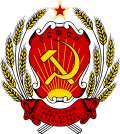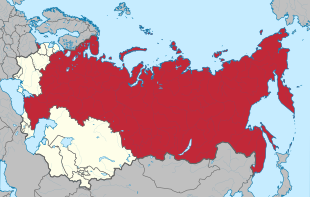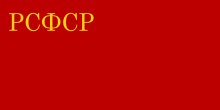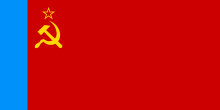Russian Soviet Federative Socialist Republic
| Российская Советская Федеративная Социалистическая Республика | |||||
|
Rossiyskaya Sovetskaya Federatiwnaya Socialisticheskaya Respublika |
|||||
| Russian Soviet Federative Socialist Republic | |||||
|
|||||
|
Motto : Пролетарии всех стран, соединяйтесь! ( Proletarii wsech stran, sojedinjaites! ) |
|||||
| Official language | Russian | ||||
| Capital | Moscow | ||||
| Form of government | Socialist republic | ||||
| Head of state |
Lev Borissowitsch Kamenew (November 9, 1917 - November 21, 1917) Yakov Mikhailovich Sverdlov (November 21, 1917 - March 16, 1919) Mikhail Ivanovich Kalinin (March 30, 1919 - December 30, 1922) |
||||
| Head of government | Vladimir Ilyich Lenin | ||||
| surface | 17,075,200 km² | ||||
| population | 147 million | ||||
| Population density | 8.6 inhabitants per km² | ||||
| currency | Russian ruble | ||||
| founding | November 7, 1917 | ||||
| resolution | December 26, 1991: dissolution of the USSR (but not the RSFSR)
April 21, 1992: Change of the state name of the RSFSR in Russian Federation through adoption of a constitution- amending federation treaty December 25, 1993: Actual dissolution through the entry into force of a new constitution as a result of the Russian constitutional crisis |
||||
| National anthem | 1917–1990: The International
1990-2000: Patriotic Song |
||||
The Russian Soviet Federative Socialist Republic ( RSFSR , Russian Российская Социалистическая Федеративная Советская Республика Rossiyskaya Sozialistitscheskaja Federatiwnaja Sovetskaya Respublika , from 1936-37 Российская Советская Федеративная Социалистическая Республика Rossiyskaya Sovetskaya Federatiwnaja Sozialistitscheskaja Respublika ) was the oldest, largest and most populous Union Republic of the Soviet Union (USSR).
It was founded shortly after the October Revolution on November 7, 1917 and was one of the founding members of the Soviet Union, which was constituted at the end of 1922 and which was heavily dominated by the RSFSR. After the dissolution of the USSR in December 1991, it then became independent from it, while exercising all its rights and obligations, and renamed itself to the Russian Federation and the Russian Federation in 1992 .
history
prehistory
The February Revolution of 1917 ended tsarist rule in Russia. This was followed by a dual government consisting of a parliament ( Duma ) and workers 'and soldiers' councils ( Soviet ). The October Revolution by the Communist Bolsheviks in 1917 fundamentally changed the character and actions of the Soviets (councils). The “limited” pluralism that was expressed in the self-designation of 1917 in revolutionary democracy was coming to an end. The Soviets initially understood themselves to be a decidedly partisan representation of the interests of the exploited classes, from which they excluded representatives or representatives of the bourgeoisie and political liberalism . But they left room for differing views on the most appropriate ways and means of improving the lot of the oppressed.
The Bolsheviks and their allies rejected this pluralism. Their delegates in the second All-Russian Congress of Workers 'and Soldiers' Deputies elected an All-Russian Central Executive Committee ( Executive Committee) from their own ranks on the evening of October 25 . Although Lev Kamenev was a proponent of a socialist all-party coalition at its head, equality was in fact already achieved. The Supreme Soviet became an instrument of the Bolsheviks.
Foundation and constitution
The new rulers systematically expanded the Soviet (council) into an alternative representative body for the full citizens of their definition. A first step was the incorporation of the All-Russian Peasant Soviet, which the third All-Russian Congress of Workers 'and Soldiers' Deputies formally implemented in the second week of January 1918. This created a central body that could function as a counter-model to the bourgeois parliament and was transferable to the province. The second step consisted in the elaboration of a formal constitution , which established such a hierarchy of councils on four levels (rural districts [Russian: wolosti ], districts [ujesdy] , governorates [gubernii] and large regions [oblasti] ) and the respective competencies regulated. This document, with which the Russian Federative Socialist Soviet Republic (RSFSR) officially entered the world of states, also fixed the fundamental characteristics of the council order in contrast to parliamentary democracy . A constitution was created under Stalin in 1937, which remained in place with many changes until it was dissolved. The government was called the Council of People's Representatives .
Typical of the council regulations are:
- the restriction of the right to vote to those who earned their living from productive and socially useful work . Whoever employed wage laborers or lived on pensions and securities was excluded; Merchants and priests were incapacitated by definition.
- the lack of separation between the executive (exercising) and legislative (legislative power), as Baron de Montesquieu ( Vom Geist der Gesetz , 1748) had first called for and had become the basis of liberal democracy since the French Revolution . Since the workers 'and peasants' state saw itself exclusively as an instrument for its clientele, the judiciary also lost its independence. So there was no separation of powers in the Soviet constitution .
- the renouncement of a direct election of the higher councils and their pyramidal appointment. In this way the door was opened to the selection of the important decision-makers. In order to counteract them, a strong pluralism would have been required even in the center of power. Lenin was able to prevent such a situation at the end of the civil war (and beyond).
Independence movements
After tsarist Russia collapsed in February 1917 and was ruled by a subsequent dual government that was overthrown by the Bolshevik Revolution in October of the same year , some national movements of the non-Russian population spoke out in favor of their own nation-state , after having only demanded more self-determination until then . Between 1918 and 1921, Soviet Russia and its Red Army also restituted the former Russian Empire and the then multi-ethnic empire . Finland , Poland occupied by the Russian Empire as the Second Polish Republic, and the Baltic states and Bessarabia became independent from the areas that belonged to the former Tsarist Empire .
Territory changes
With the establishment of the Soviet Union at the end of 1922, large parts of Soviet Russia were incorporated into it as independent Union republics . At the beginning of the 1920s, the Far Eastern buffer states between the Japanese Empire and Soviet Russia (i.e. the Far Eastern Republic or the coastal republic ) became part of the RSFSR and in 1925 the area around the previous Kyrgyz capital Orenburg was separated from the area of the subsequently formed Kazakh ASSR .
In the process of dissolving the governorates inherited from the tsarist empire , which was completed by the end of the 1920s, the RSFSR went through a phase of frequent administrative changes. In the 1920s, a few new governorates were formed that only existed for a short time. The RSFSR was reorganized into larger, then smaller and more often renamed oblasts (areas) and krais (regions), which in turn were episodically subdivided into okrugs , before the formation of the essentially still existing ones from the second half of the 1930s Oblast and Krais established a more permanent structure. The 1936 Constitution (Stalin Constitution) contributed to this. After the abolition of Ujesdi and Okrugs , the oblasts and krais were subdivided into Rajons (districts). The Soviet nationality policy led to the formation of Autonomous Soviet Republics , Autonomous Oblasts and Autonomous Circles (referred to as National Circles until 1977 ).
The biggest changes in the territory of the Russian SFSR happened around World War II . The Finnish territories conquered in the winter war of 1939/40 were partly added to the RSFSR and partly united with the Russian parts of Karelia to form the Karelo-Finnish SSR .
In 1944, the Tuvinian People's Republic , which had actually been Soviet since the 1920s, joined the Soviet Union, first becoming an autonomous area and later an autonomous republic within the RSFSR. After the violent incorporation of the Baltic States into the Soviet Union in 1940, some border towns of Latvia and Estonia were incorporated into the RSFSR.
After Finland lost the Continuation War in 1941/44, it had to cede further smaller areas (especially Finland's only access to the Arctic Ocean) to the Soviet Union in 1947. In the west, the Soviet Union incorporated the north of East Prussia around Königsberg , today 's Kaliningrad Oblast , into the RSFSR. In the east, the island of Sakhalin , which had long been disputed between Russia and Japan and which the Soviet Union occupied at the end of the Second World War, and the Kuril Islands fell to the RSFSR.
In 1954, the area of the RSFSR decreased when, on instructions from Nikita Khrushchev, the Crimea was surrendered to the Ukrainian SSR . In 1956 the Karelo-Finnish SSR was dissolved and incorporated into the RSFSR as the Karelian ASSR .
population
According to the last census in 1989, about 147 million people lived in the RSFSR , which represented approximately 51% of the total population in the USSR. The population at that time consisted largely of the following population groups:
| nationality | Population | Nationalities |
|---|---|---|
| Russians | 120 million¹² | 81.5% ¹ |
| Tatars | 5.5 million¹² | 3.8% ¹ |
| Ukrainians | 4.3 million¹² | 3.0% ¹ |
| Tschuwaschen | 1.8 million¹² | 1.2% |
| Bashkirs | 1.3 million¹² | 0.9% |
| Mordwinen | 1.0 million¹² | 0.7% |
| Entire RSFSR | 147 million¹² | 100.0% |
¹ Population figures and percentages according to Roland Götz / Uwe Halbach.
² Population according to RA Mark.
Of the more than 27 million non-Russians in the RSFSR, only 9.4 million (as of 1989) lived in their actual national or historical areas, as they had left these areas through flight, resettlement or of their own accord. The distribution area of some peoples such as the Tatars is traditionally very scattered and could not be completely covered in a compact autonomous area from the start.
literature
- Victor Dönninghaus: Minorities in Distress. Soviet policy towards Germans, Poles and other diaspora nationalities 1917–1938 (= writings of the Federal Institute for Culture and History of Germans in Eastern Europe; 35). Oldenbourg, Munich 2009, ISBN 978-3-486-58872-9 .
- Roland Götz, Uwe Halbach: Political Lexicon GUS (= Beck'sche series 852, countries). 3rd, revised edition, Beck, Munich 1995, ISBN 3-406-40597-5 .
- Andreas Kappeler: Russia as a multi-ethnic empire. Origin, history, decay . Beck, Munich 1992, ISBN 3-406-36472-1 .
- Rudolf Mark : The peoples in the former Soviet Union. The nationalities of the CIS, Georgia and the Baltic States. A lexicon . 2nd, revised and expanded edition, Opladen 1992, Westdeutscher Verlag, Opladen 1992, ISBN 3-531-12075-1 .
- DS Polyanski: Russian Socialist Federative Soviet Republic. The Whole Republic a Construction Site . Soviet Booklets, London 1959 ( online ).
- Gerhard Simon , Nadja Simon: Decline and fall of the Soviet empire (= dtv science 4598). With numerous documents. Deutscher Taschenbuch-Verlag, Munich Munich 1993, ISBN 3-423-04598-1 .
- Gerhard Simon: Nationalism and Nationality Policy in the Soviet Union. From totalitarian dictatorship to post-Stalinist society (= Eastern Europe and international communism; vol. 16). Nomos-Verlags-Gesellschaft, Baden-Baden 1986, ISBN 3-7890-1249-1 (also: Cologne, Univ., Habil.-Schr.).
- Norbert Wein: The Soviet Union (= university paperbacks 1244). 2nd, revised and expanded edition, Schöningh, Paderborn [u. a.] 1985, ISBN 3-506-99366-6 .
Web links
- RSFSR constitutions (Russian)
Individual evidence
- ^ Constitution of the Russian Federal Socialist Soviet Republic (Basic Law, 1937). Retrieved August 2, 2020 .
- ^ Roland Götz, Uwe Halbach: Political Lexicon GUS. 3rd edition, 1995.
- ^ RA Mark: The peoples in the former Soviet Union: The nationalities of the CIS, Georgia and the Baltic states. A lexicon. 2nd Edition. Opladen 1992.






